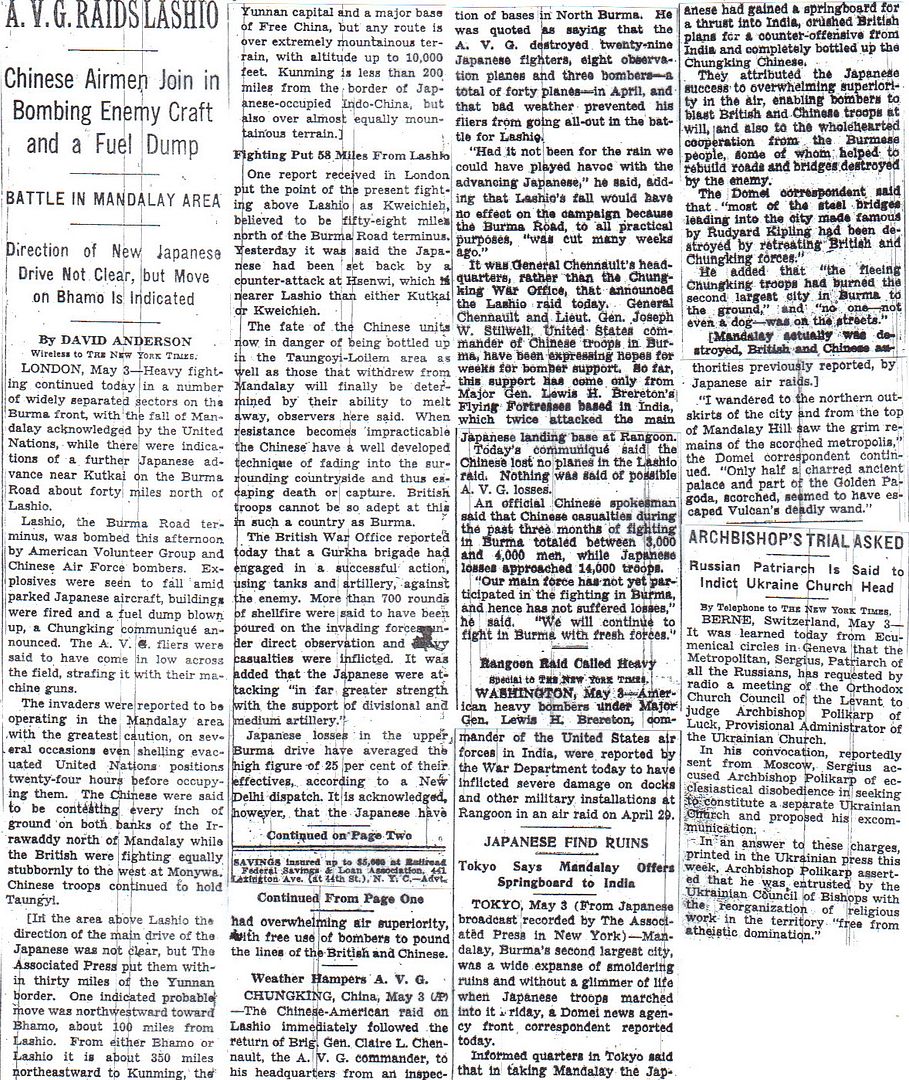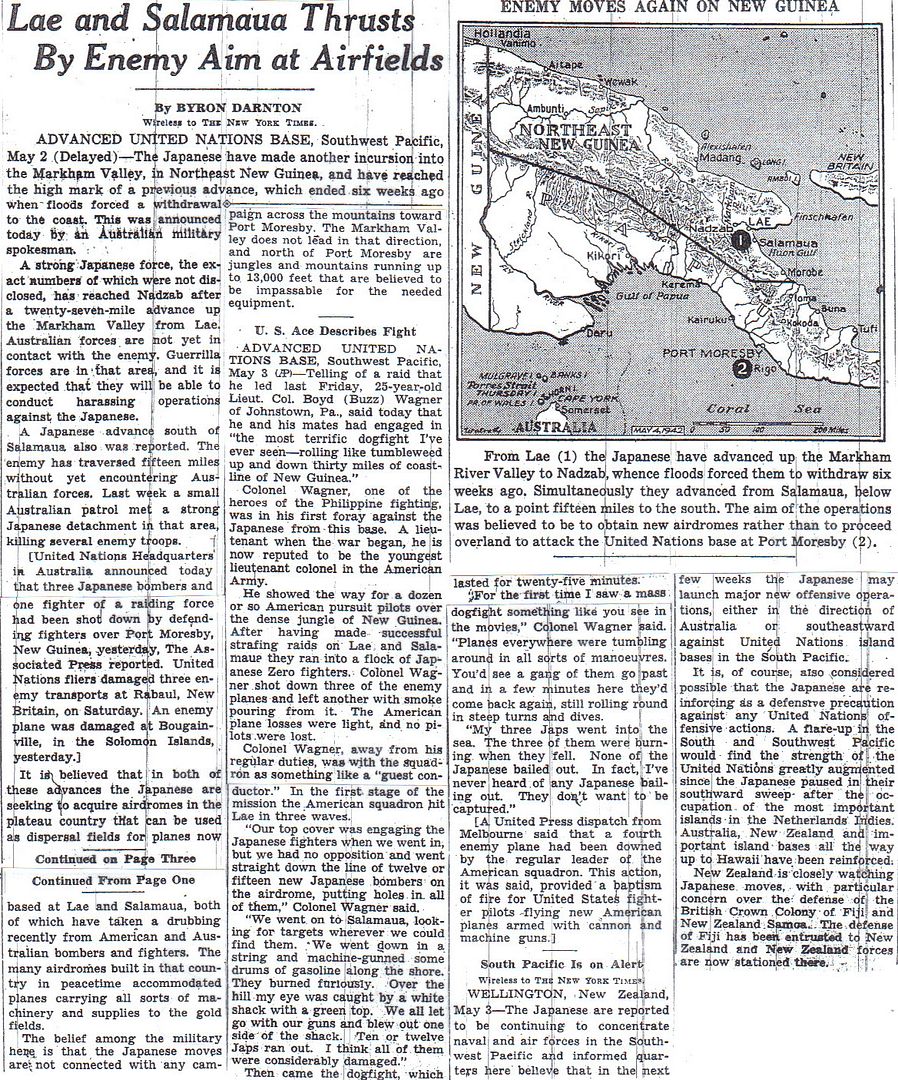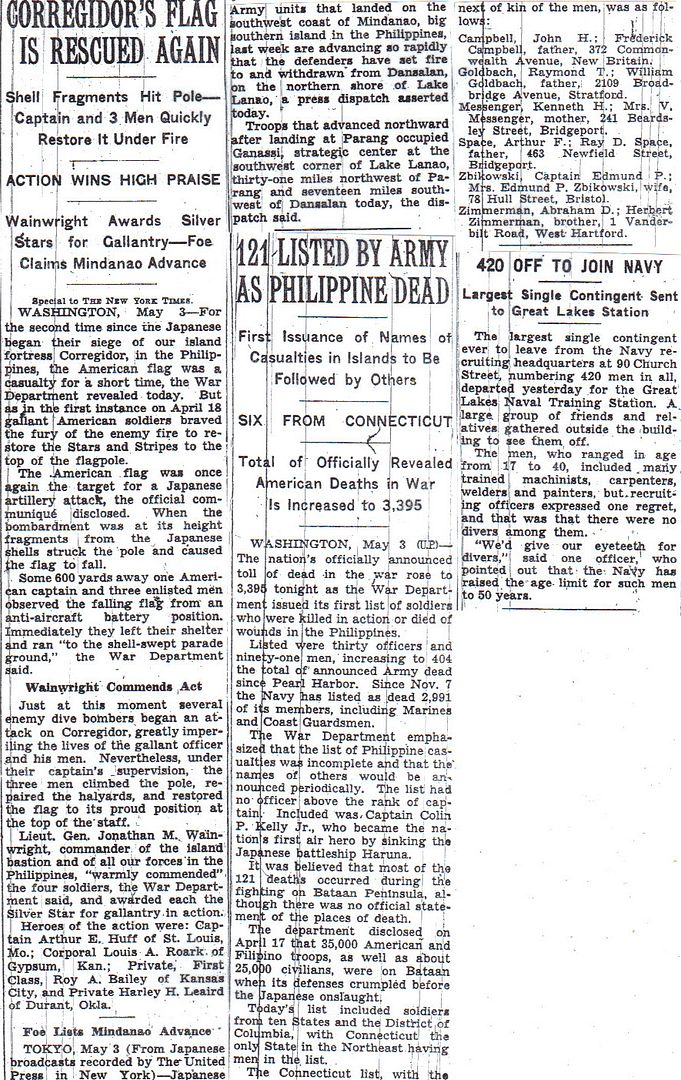
Posted on 05/04/2012 4:57:10 AM PDT by Homer_J_Simpson










http://www.onwar.com/chrono/1942/may42/f04may42.htm
Japanese bombarding Corregidor
Monday, May 4, 1942 www.onwar.com
In the Philippines... Fighting lessens on Mindanao. Japanese bombardment of the American forces on Corregidor is very intense.
In the Coral Sea... Aircraft from the USS Yorktown positioned 100 miles south of Guadalcanal, attack Japanese forces off Tulagi. The Yorktown then returns south to join the American Task Force 17 which is assembling to engage the Japanese. American actions are dictated by their code breaking which has revealed many of the Japanese plans to them.
In Burma... Chinese units are forced to withdraw from Wanting on the all important Burma Road and at Bhamo on the Irrawaddy. At Akyab, the British evacuate before Japanese advances.
http://homepage.ntlworld.com/andrew.etherington/frame.htm
May 4th, 1942
UNITED KINGDOM: Exeter: Exeter was bombed again last night in the latest of a series of raids in reprisal for the RAF’s bombing of the historic cities of Lubeck and Rostock at the end of March. Exeter was first to suffer, on 24 April, followed by Bath, Norwich and York.
Many people died in last night’s raid, which wrecked the old centre of Exeter. One German official has said these attacks are “Baedeker raids”, aimed at British towns designated of great cultural interest in the Baedecker guides. But his nickname seems to confirm that the Nazis as vandals; Goebbels is furious at this propaganda own-goal.
Boom defense vessel HMS Barbourne launched. (Dave Shirlaw)
NETHERLANDS: Amsterdam: In a nationwide crackdown on the growing and anti-Nazi resistance movement in Holland, the Germans today executed 72 members of the Dutch underground by firing squad. Seven others were sentenced to life imprisonment. Army officers were among the victims.
A German statement broadcast on Hilversum radio said that the men were found guilty of making contact with Germany’s enemies and possessing arms and explosives. The executions are seen as evidence that the Nazis have given up hope of persuading the Dutch to support Hitler’s New Order.
GERMANY: U-965 laid down. (Dave Shirlaw)
SWITZERLAND: Honey, jam and preserved fruits are rationed. (William Jay Stone from http://www.geschichte-schweiz.ch/en/worldwar2.html)
INDIAN OCEAN: The British attacked the French Island of Madagascar. (Dave Shirlaw)
BURMA: Akyab is evacuated by the British. The Chinese are defeated at Tating on the Burma River and at Bhano on the Irrawaddy River.
The collapse of the bid to establish a firm Allied defensive line in central Burma has led to the final phase of the military campaign. Today the Japanese took Akyab; the last port in Burma is now in enemy hands. The Japanese capture of Lashio on 29 April has cut the Burma Road to China. There remains now only an air transport kink across the “hump” from Dinjan to Kunming. Elements of the Chinese armies operating in Burma have reached Ledo from Myitkyina. The bulk of their formations have crossed into China.
COMMONWEALTH OF THE PHILIPPINES: The Japanese bombardment of Corregidor becomes intense in preparation for the eventual landings. In 24 hours, Japanese artillery fires 16,000 shells at US positions.
Minesweeper USS Tananger sunk by shore batteries off Corregidor. (Dave Shirlaw)
PACIFIC OCEAN: The Battle of the Coral Sea begin. Aircraft from the USS Yorktown attack Japanese Naval forces off Tulagi in the Solomon Islands.
Beginning at 0845 hours, 28 Douglas SBD Dauntlesses of Bombing Squadron Five (VB-5) and Scouting Squadron Five (VS-5) and 12 Douglas TBD Devastators of Torpedo Squadron Five (VT-5), escorted by Grumman F4F Wildcats of Fighting Squadron Forty Two (VF-42) from the USS Yorktown (CV-5) Air Group attack a Japanese invasion flotilla and shore facilities in an around Tulagi. During the day, these aircraft sink a Japanese destroyer, a minesweeper and two auxiliary minesweepers and damage a destroyer, a minelayer, a transport and a cargo ship. The US loses three aircraft.
In another phase of Operation “MO,” a Japanese invasion force bound for Port Moresby, New Guinea departs Rabaul on New Britain Island in the Bismarck Archipelago. A IJN task force consisting of the aircraft carriers HIJMS Shokaku and HIJMS Zuikaku is also in the area and is sighted by the crew of a USAAF North American B-25 Mitchell. The crew reports the ship’s position but is driven off by IJN carrier-based aircraft and is unable to regain the contact. (Jack McKillop)
And in a finale for the day two F4F pilots (Ed Bassett and William Leonard) from VF-42 shot down three F1M2 (later code named ‘Pete’) floatplanes near Tulagi. AFAIK this was the first encounter of the ubiquitous ‘Pete’ byUSNcarrier based aircraft. Joining up with the other two F4Fs of their division they then attacked the destroyer YUZUKI off the coast of Guadalcanal in a series of strafing runs, killing 10 men (including the captain) and wounding 20 more. Incendiary rounds started fires and AP rounds punched numerous holes through the hull. The YUZUKI limped back to Rabaul trailing oil. (Rich Leonard, son of the pilot)
U.S.A.:
Destroyer USS Harrison launched.
Submarine USS Rasher laid down.
Submarine USS Herring commissioned. (Dave Shirlaw)
ATLANTIC OCEAN and CARIBBEAN SEA: German submarines sink three US freighters and three US tankers. (Jack McKillop)
SS Tuscaloosa City sunk by U-125 at 18.25N, 81.31W.
At 0943, the unescorted and unarmed Eastern Sword was torpedoed by U-162 about twelve miles off the Georgetown Light. Two torpedoes struck in quick succession on the port side at the #4 hold aft of the midship house, causing the ship to settle rapidly by the stern. Two minutes later water reached the decks and she sank on an even keel with 15 feet of her mainmast above water. The explosion had destroyed the radio shack, preventing the sending of a distress message. Three officers and nine crewmen of seven officers and 22 men abandoned ship in one lifeboat and landed the next day at Georgetown. One crewman was picked up from a raft by the fishing boat Ocean Star on 6 May and landed in Georgetown.
Sailing vessel Florence M. Douglas was sunk by gunfire from U-162.
At 1742, the unescorted and unarmed Norlindo was torpedoed by U-507 about 80 miles NW of Dry Tortugas Island. One torpedo struck on the starboard side aft between the #3 and #4 hatches, causing the mainmast to fall. The ship began sinking quickly, listed to starboard and finally sank by the stern. The seven officers and 21 crewmen on board did not have the time to launch the lifeboats and jumped overboard, but five men working in the after hold went down with the ship. The survivors were picked up from four rafts by San Blas two days later and landed at Cristobal on 11 May. At the time of the attack, two tankers lay in view of the Norlindo, the Joseph M. Cudahy and Munger T. Ball, one about ten miles to the east and the other just over the horizon. Schacht questioned the survivors, even providing them supplies and then went on to chase the other ships and managed to sink both.
At 1904, U-564 torpedoed the Eclipse and observed the tanker grounded by the stern, but the ship was later salvaged.
Due to technical problems U-590 had to return to base.
U-507 gave water and food to shipwrecked survivors of the sunken ship Norlindo.
U-456 encountered a Soviet submarine in the Arctic Sea, but neither boat attacked.
I kinda like the story about the SEVEN YEAR OLD KING of Iraq!
http://corregidor.org/btty_histories/control/open.htm
The artillery had begun its preparatory fire on 1 May and by the evening of the 5th had laid waste the entire north shore of Corregidor. That night, after the first troops had embarked at Lamao, the artillery concentrated first on the remaining mobile guns and searchlights on the island and then on the stretch of beach between Infantry and Cavalry points. Just before the landing, the artillery had shifted its fire westward, to Malinta Hill. To assist in artillery fire that night and next day, General Kitajima had placed a liaison group of sixty men in the assault boats. They would go ashore with the first waves and establish artillery observation posts on Malinta Hill as soon as it was taken.
By the time the artillery and air forces had opened the final phase of the bombardment, the 4th Division had won its fight against malaria and was ready to move into the assembly area. On 4 May, X minus 1, Colonel Sato had assembled his left wing units in the Lamao River valley, near Cabcaben, and the next day marched them to Lamao where, at dusk, they began to embark for Corregidor. The run to the island was made in darkness, the troops expecting to land about 2300, an hour before moon-rise. Earlier that day, after Sato moved out, General Taniguchi’s right wing assembled near Cabcaben in preparation for their assault the next night, 6 May.
http://usswashington.com/worldwar2plus55/dl03ma42.htm
May 4th, 1942...HMNZS Achilles and HMNZS Leander arrive in Vila, and stay there for two weeks, assisting to unload ammunition from storeships to barges, and providing AA protection while American Seabees build roads, barracks, supply dumps, and a workable airstrip.
At 6:30 a.m., 12 Devastator torpedo bombers and 28 Dauntless dive bombers from the carrier USS Yorktown attack the massed Japanese ships at Tulagi. The raid catches the Japanese and coastwatcher Martin Clemens by surprise. The American planes swoop down, and overestimate what they see, identifying a minelayer as a light cruiser, and minesweepers as transports. They hammer the targets and go home by 9:30, having sunk the destroyer Kikuzuki and three minesweepers. A second strike punches out two seaplanes and damages a patrol craft, while a third attack sinks four landing barges. The Americans lose only three planes. Despite the elated mood on Yorktown, Japanese losses are minor. The Battle of the Coral Sea has begun.
In Hashirajima Bay, Japanese senior officers wargame the attack on Midway, using a complex game developed by their officers. Battle results are determined by dice roll according to combat results tables, to introduce random events. In the paper battle, American carrier planes catch the Japanese carriers Akagi and Kaga and sink them. Vice Adm. Matome Ugaki overrules umpire Masatake Okumiya to refloat Akagi. In the follow-up game, Kaga is also re-floated...and in both battles, the Japanese win. Success thus assured, the mimeograph machines start to roll, and the Navy is directed to carry out “General Order No. 18,” which will attack targets “AO” and “AF.” The air is soon thick with radio transmissions, coded in JN-25, the top-level code.
These messages all land on the desk of Cdr. Joseph Rochefort, a Japanese-speaking intelligence officer at Pearl Harbor, who heads FRUPAC, the Pacific Fleet’s team of codebreakers, who, after a great deal of sweat and mathematics, can unreel JN-25. Many of the messages refer to a target named “AF.” Nobody can figure out what it is, until an officer looks down a Japanese map and observes that Midway stands at the cross of grids “A” and “F,” and that an enemy snooper plane reported being near “AF” when on a flight near Midway. CINCPAC, Adm. Chester Nimitz, believes this theory. Washington, however, does not. Adm. Ernest King fears a Japanese assault on Hawaii or a raid on the West Coast. The Army worries about an attack on the Panama Canal. Washington demands proof of Rochefort’s theory.
On Corregidor, the Americans, down to one week’s water, are ready for the worst. AA guns are out. Telephone lines are out. Rations are down to a little canned salmon and rice. Showers are out. The last Navy gunboat, Mindanao, has been sunk. The last two PBYs from Australia have flown in to evacuate 50 passengers, including radio intercept specialists and nurses. Wainwright expects the invasion next evening, during the full moon.
Japanese troops invade Mindanao at Cagayan and press south along the Sayre Highway, a dirt track.
Speaking of Rear Admiral Frank Jack Fletcher (as this excerpt does), I noticed an interesting coincidence. One of the destroyers pictured in the news today is named after the late Rear Admiral Frank Friday Fletcher. There has to be a connection, right?
http://en.wikipedia.org/wiki/Frank_Friday_Fletcher
Fletcher was born on November 23, 1855, in Oskaloosa, Iowa. He was the uncle of World War II Admiral Frank Jack Fletcher. He graduated from the U.S. Naval Academy in 1875 and spent the next year as a midshipman on USS Tuscarora.
This guy, except for his gentlemanly instincts seen here, may have been the Mush Morton of the Kriegsmarine. On this patrol, he:
Schacht's humane bent eventually earn Hitler's ire, as he was the captain rescuing survivors in the Laconia incident, which led to Hitler's ban on rescuing non-officer survivors.
In his next patrol, Schacht will singlehandedly bring Brazil into the war against Germany by sinking six Brazilian ships. This was particularly unfortunate for him, as the U-507 was later sunk with all hands by a Catalina.
Flying from the territory of our new ally...Brazil.
"The Mauthausen concentration camp, located near Linz in upper Austria, was renowned for its cruel working conditions.
The camp included within its confines a stone quarry in which prisoners were assigned to backbreaking work.
While pushing heavy carts or carrying stones weighing over 100 pounds, prisoners were forced to ascend the "staircase of death."
Composed of 186 steps, the staircase meant death for any prisoner who lost his or her footing and fell under the loads.
Later in the war Mauthausen prisoners were assigned to build underground tunnels for weapons production."
Dang...they coulda used this guy...
Disclaimer: Opinions posted on Free Republic are those of the individual posters and do not necessarily represent the opinion of Free Republic or its management. All materials posted herein are protected by copyright law and the exemption for fair use of copyrighted works.